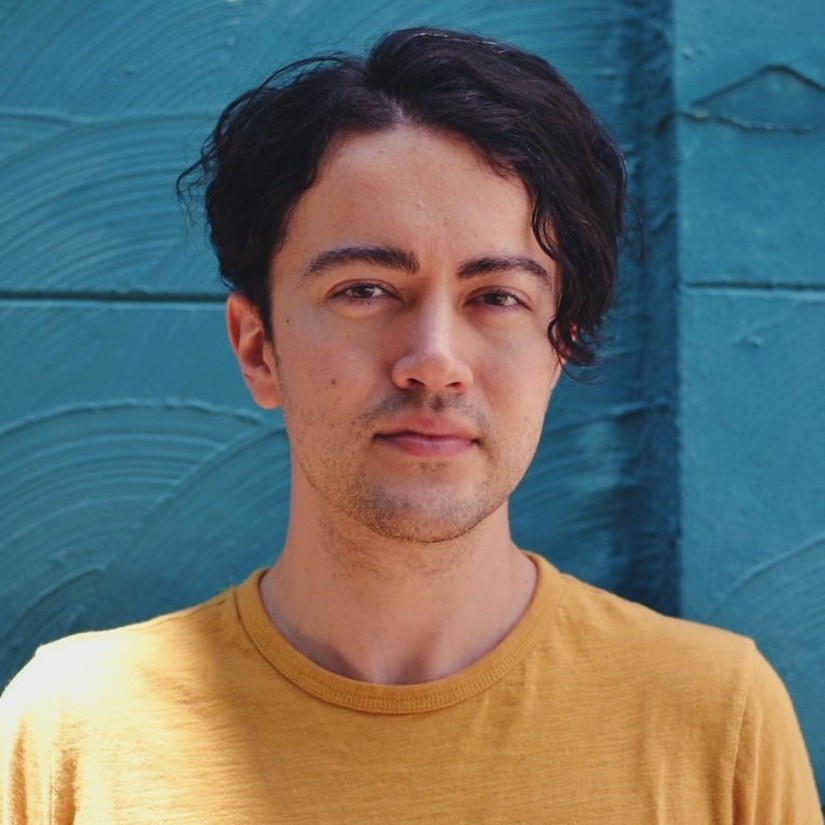take the tortillas out of your poetry
Poetry that Sows and Sings in Zoque
Mikeas Sánchez
The poetry of Mikeas Sánchez (1980) is a lyrical breath of telluric strength. This is especially palpable in her poetry collection Mojk’jäyä / Mokaya, whose title means “corn flower,” as we read in one of its verses. Her poems, inhabited by extraordinary entities and by voices both feminine and masculine, recreate song and prayer through their rhythmic patterns, as we read in her texts inspired by the traditional dances of her birthplace: Chapultenango, Chiapas. Her verses are bridges that connect us to the sky, the water, and sacred figures: Sawabät (Lord of the Wind), Mä `ä bät (Lord of the Lightning), and Tujbät (Lord of the Rain), to name just a few. Her bilingual writing offers us a chance to glimpse the linguistic universe of Zoque, a language whose roots lie in the Olmec culture, Mexico’s oldest civilization. The poetry of Mikeas Sánchez is an inestimably valuable path towards knowledge of Zoque and its intersection with Spanish. Mikeas Sánchez’s name echoes loudly in Mexican literature; she is a fiction writer, a poet, and the author of the poetry collections Maka mujsi tumä jama / Y sabrás un día (2006), Äj’ ngujkomo / Desde mi médula (2011), Mumure’ tä’ yäjktambä / Todos somos cimarrones (2012), Kobikyajubä’jaye / Selección poética (2013), Mojk’jäyä / Mokaya (2013), and Jujtzye tä wäpä tzamapänh’ajä / Cómo ser un buen salvaje (2019). In the latter two collections, we find references to her grandfather, Simón Sánchez, who was a medicine man, a musician, and a dancer. Mikeas’s writing demands our attention.
Krishna Naranjo Zavala: Mikeas, in your poetry book Mojk’jäyä / Mokaya you make constant mention of the earth, prayers to the earth, sowing time. Did you conceive of the book in these terms?
Mikeas Sánchez: Yes, that’s how I thought of it, like a poetry book that could connect me to nature, to the ancestors, to the community practices that have been pushed to one side. I am a daughter of peasants, and throughout my childhood I was constantly reminded of how the peasant’s work—working the land—is a very hard job, requiring lots of physical effort. But, at the same time, the products of this work, the fruits of the earth, have been undervalued… we don’t consider the implications of physical work, or the spiritual element of the simple fact of planting a seed in the ground.
I also wanted to honor the work of my grandparents, of my dad, who have always been peasants and who, at a certain point in their lives, were happy doing their work, until the capitalist system came into place. In their communities, their work began to be the work of poor people, the work done by people who didn’t go to school. Their work became worthless because it didn’t offer you a means to acquire products. Working the fields is self-sustaining; it doesn’t allow you to generate profits or money but it does allow you to provide for yourself, with a healthy, sustainable life. That’s what I wanted: to present this knowledge that comes from the community and doesn’t make sense to those who see a kilo of tortillas and don’t know where that kilo of tortillas came from.
K.N.Z.: When you mention community practices, I think of the poem “Kujkiki,” which suggests a certain rhythm when spoken aloud. As a reader, you look at the footnote and realize that this word’s meaning is untranslatable; it refers to “the sacred word of the seed sower.” Is there a certain community practice that gave rise to this poem?
M.S.: Oh, of course! It’s about a dance that takes place on February 2, the seed sower’s dance. In Chapultenango, these dances have always taken place before our sowing celebrations. Everything had to adapt to the Catholic calendar, and this dance adapted to take place on February 2, which is Día de la Candelaria or Candlemas. But Candlemas has nothing to do with our celebration, you don’t notice it; it is somehow folded into the dance. It happens in front of the church and in the town’s streets. It’s one of the oldest dances we have in our community, and it brings everybody together. Everyone knows that, after that dance, it will be time to sow.
K.N.Z.: Have you read that poem in your community?
M.S.: No, I haven’t read much poetry in my community… we do other community activities, like sharing information, for example.
K.N.Z.: Returning to the poem itself, the word “Kujkiki” defines the poem’s rhythm, which in itself reflects a ritual practice. Is that right?
M.S.: Yes, that’s intentional. It’s also about the rhythm itself, like in prayer, in the role of the head dancer, who is the seed sower. I try to recreate that rhythm, just as we hear it in the community every year, but without awareness of what it means. I think a lot about the violence our peoples experienced when they had to do away with their rituals and community practices; they had to be very creative to find ways to fit them into Catholicism, into their dances. This dance in particular is special because the seed sower is not only a dancer; he is also an actor who speaks to us while he simulates sowing, he simulates making the milpa, tending to the milpa, sowing corn and other crops too: pumpkin, chayote, yucca; everything that went into the community he sows, and he says something about every little thing he puts into the earth.
It’s funny for the people who are listening, but it also has philosophical meaning. Of course, there is no awareness of that part; the people laugh, and the dancer, in our mother tongue, makes very ingenious use of humor. In doing so, he creates a form of entertainment, a show, and people from all around come to see the dance. But, in reality, the man is acting out an ancient teaching he wants to share with us.
K.N.Z.: When you use terms with no translation, such as “Nasakobajk,” “ore `pät,” and “ore `yomo,” do you mean to suggest a linguistic approach to the book?
M.S.: Yes, to force the reader—even if they have to read it two or three times, and they won’t understand it at first—to look it up in the footnote or in the glossary. I don’t even consider finding a translation in such cases because none exists. I would not be able to find one in Spanish, because in Spanish this sort of practice does not have the same meaning. I could try to explain within the translation, but that would mean losing the rhythm, so I prefer for the reader to find out for themself, as best they can.
K.N.Z.: In your poems we meet sacred entities like Nasakobajk. Does this vision of Nasakobajk, for example, exist among your family, in your community, or did you have to do research and recover that tradition?
M.S.: It does exist, but I didn’t always have the awareness necessary to undertake this kind of recovery, to understand that it has a much older meaning. For example, in the case of Nasakobajk, which is mother earth, my mom—despite the stark Catholicism of our community—whenever we went to a new, strange place, would tell us we had to kneel and ask permission from Nasakobajk to go and live there. When we went into the woods it was the same way, and even when something happened to you, when someone did something to you, she would say that crying to Nasakobajk was very powerful because everyone walks on the earth; so no one can be above anyone else, we are all eventually going to return to the earth; the earth has a very important presence in our lives. If you’re going to cry to someone, you can’t cry to a cross or an image, but if you cry to the earth it does something really strong, because the earth has a life of her own, and we are part of this earth. These are things that happen all the time, but without any awareness of why.
K.N.Z.: Which poets do you like to read? What do you make of the current scene of poetry written in Indigenous languages, especially by women?
M.S.: I read a lot of novels. I really like the novel genre because our literary tradition is more narrative. I grew up with narrative, listening to stories told out loud…
K.N.Z.: You can tell from your narrative poetry.
M.S.: I really like to tell stories because it comes from the oral tradition, but the first ones to tell stories had a skill that is rare nowadays. They knew how to draw you in from the first word you heard, keeping you there, even making you anxious for them to go on, fighting against sleep. They knew how to thread together thought and language to keep a hold on you… so I like to tell stories. In poetry, I try to tell stories that let me create images, so your imagination can generate characters.
Women are producing a great deal at the moment, in both poetry and fiction. I think each one has her own cultural particularities, which are interesting to get to know. The new generations will see these women writers as reference points, the ones who dare to break down the cultural and family barriers that we women face. It’s always more complicated for us, being a woman who writes is different from being a man who writes. The same thing happens in the world of work. Women who work as teachers, lawyers, and engineers get back to their homes and have to pull a double shift.
K.N.Z.: “Nereyda’is myabaxäyu nwyt New’York” / “Nereida se soñó en New York” is a poem with a narrative echo that touches on the subjects of the city, migration, the Tzitzun empire, and Nereyda’s own experience, as well as the loss of the Zoque language. What can you tell us about this poem, this other aspect of your writing that makes social demands?
M.S.: In Indigenous communities, including mine, there is a lot of migration. It’s a “dream”—an American dream, at that—that comes about because we don’t value what we have in the community, in the fields, because that’s what we have: the generous fields, the fields that give us the food we need to feed ourselves. But there is this other part of us that wants to have. This having is often in conflict with being, when the people of our community want to have. They want to have a big house, to have a big car, to have a bank account, stylish clothes, to go to restaurants, to the movies; they want to have because that’s what the media demands of us, that’s what they tell us in school, that you have to be somebody. This struggle ends up causing a lot of unhappiness. Unhappiness that, sadly, you can only understand when you have enough emotional maturity, and sometimes that comes very late, when things have already gotten really bad, when you’ve already left your children behind, when you’ve had to go through a lot of hardship because people suffer also in the north, they suffer violence, they don’t live like they live in Mexico, where they can at least move around as they please. All of this is also a form of violence.
Writing this sort of poem allows me to reflect characters; a character, out of all the characters that exist, who has been lucky enough to have and has still not been able to get there. But that’s the right thing to do, because there are a lot of things lacking in the community, things that have been seen as lacking but really aren’t so much, but things that, when you live in a context that tells you you have to have them, make you feel as if you’re missing something. So you look for it, and sometimes what you find is death. It’s sadness, depression, desolation, and neglect of the people you love. You exchange certain things for others.
K.N.Z.: I read “Cómo ser un buen salvaje” as a reflection on what it means to be Indigenous. Is that right? There’s a debate there surrounding Indigenous literature, this tag we put on the word.
M.S.: I remember José Antonio Reyes Matamoros, one of the originators of writing in this area of Los Altos de Chiapas. I’m from the northern part of the state, so, when I came to study with him, there was always a little friction because I was already trained in literature. I didn’t go there to learn to write, I wanted to learn other things. He was always the teacher, though, and he was always repeating this line that writers had to write about nature, about the fields, about life, about cosmology. And I wasn’t writing about those things at the time, because it just didn’t come for me, and I didn’t want to force my writing toward something it didn’t want to be. That seemed like a somewhat dishonest and unethical thing to do. And, curiously, that’s what I do now, but only because I like it, because I feel it, because I think I can make some small contribution to everything that’s going on in the world, and I do it under no pressure. When I was starting out in those workshops, it just wasn’t the right time.
K.N.Z.: I think your poems are there to be told, to transmit the realities of hard situations, like how “Nereyda se soñó en New York” reflects on the phenomenon of migration that we are seeing and living through. I think you’re a poet who has succeeded in communicating a great deal.
M.S.: I’m glad, because I’m also one of the first of my people to write. I think I’m an important reference point in my community for future generations, and I like it when new people come up and greet me. They’re curious because we’re from up north. We’ve been the most forgotten, since we’re not really from Chiapas, but we’re not from Tabasco either—we’re the most overlooked.
K.N.Z.: Plus your language is not Maya, it comes from a different linguistic family.
M.S.: It’s Zoque, so they consider us to be very small, and even within our communities there are those who commit violence against Indigenous peoples. We have lived through all of this intensely, and it’s reflected in how minimal and scarce our literary production is. But there are still people doing it.
K.N.Z.: Thank you, Mikeas!
San Cristóbal de las Casas, Chiapas, June 5, 2019





